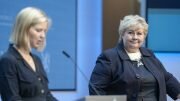Last week, the Norwegian government decided that Norway would move to normal everyday life with increased emergency preparedness on Saturday, September 25, at 4 PM. Here are the details.
The Norwegian Directorate of Health and the Norwegian Institute of Public Health have recommended moving to normal everyday life with increased emergency preparedness at the end of September/beginning of October. After closely monitoring the situation this week, the Norwegian government has decided to move to normal everyday life with increased emergency preparedness on Saturday, September 25, at 4 PM.
“Even though most people’s everyday lives will now return to normal, the pandemic is not over. People will continue to get sick, which is why it is important that everyone gets vaccinated. In addition, society will have increased preparedness and quickly be able to take action if the situation calls for it. The municipalities will continue to play an important role in responding if outbreaks put the capacity of the health service under pressure,” Prime Minister Erna Solberg noted last week.
The following rules and advice apply in “A normal everyday life with increased emergency preparedness”
As of last Saturday, September 25 at 4 PM, all domestic restrictions have been removed, apart from the requirement of going into isolation if you have COVID-19.
“We no longer need to keep a distance. We can spend time with people the way we did before. We are removing the restrictions on the number of people who can attend events together.
“Drinks no longer need to be served at tables, and admission after midnight is no longer banned,” Solberg explained.
If you have any respiratory symptoms, you should still get tested. This also applies to people who are vaccinated. If you are infected with COVID-19, you need to go into isolation in order not to transmit the virus to others. This is not a recommendation but a rule that comes with a fine if you fail to comply.
Unvaccinated people who live with someone who is infected are advised to take a test or quarantine, regardless of whether they have symptoms or not. Other unvaccinated close contacts do not need to quarantine but should take a test.
“We will also keep the advice we all know so well: wash hands often, cough into a tissue or our elbow, and stay home if we are sick,” Solberg noted.
Even though most industry standards and infection control guidance will now be revoked, Solberg encouraged businesses to keep good infection control measures, such as customers having access to hand sanitizer.
“We are keeping the traffic light model for schools and kindergartens. If a municipality believes that the situation calls for local measures, the traffic light model will offer good guidance. This is important in order to give students the most normal everyday lives possible. Even though increasing numbers of people are vaccinated, situations may still arise that call for local measures.
“In short: we can live like normal now,” Solberg said on Friday.
Adjustments to the strategy
The primary objective of the Norwegian government’s strategy so far has been to keep the pandemic under control. Because so many people now are vaccinated, the assessments of what is required to keep the pandemic under control have changed. The transition to normal everyday life with increased emergency preparedness means that Norway is moving from a control strategy to a preparedness strategy.
“The new objective of the Norwegian government’s strategy is to prevent the pandemic from resulting in a considerable disease burden that puts a strain on the capacity of the municipalities and hospitals. At the same time, people should live as normally as possible. Public services must operate at an appropriate level, and the economy must be protected,” Minister of Health and Care Services Bent Høie said on Friday.
The following four indicators will be applied when the authorities assess how large a disease burden we must be able to handle:
- The number of patients in hospital
- The number of patients in intensive care units
- The age distribution of patients
- Capacity in the municipalities
The COVID-19 infection rate will therefore play a smaller role in the future, while the overall burden, which includes the flu and RSV, will become more important.
Preparedness moving forward
“We are lifting most national infection control measures, and the municipalities will have primary responsibility for implementing measures and adopting local regulations if the situation calls for it. In the face of large outbreaks that are difficult to map and that threaten capacity in the municipalities, it may be necessary, for example, to introduce measures for groups at particular risk, like the elderly and the sick.
“We have had a good dialogue with the municipalities, and have informed them both orally and in writing that they need to be ready to introduce local regulations when necessary,” Høie pointed out.
The municipalities must have test preparedness going ahead. They must be able to hand out rapid antigen tests to 10% of the population per week, have the capacity to test 1% of the population per week and, at one week’s notice, be able to increase test capacity to 5%. They must be able to maintain a vaccination capacity of 200 000 doses per week and have preparedness that makes it possible to considerably increase capacity over a 4-week period.
The regional health authorities must have plans that allow for many patients to be admitted to hospital with COVID-19 and other infectious diseases at the same time, and have preparedness for good capacity to perform analyses in their laboratories and for increased sick leave among employees.
“We must have good national monitoring systems that quickly detect outbreaks and new virus variants, but the municipalities must naturally also monitor the local situation. All of this is required in order to be prepared to handle any changes in the situation. The Norwegian government has determined that we must maintain this preparedness until the end of the year, at the very least.
“We recommend that the strategy be reviewed at the end of the year. But everyone must be prepared for increased preparedness to be maintained throughout the winter of 2022. The Norwegian government has assured the municipal sector that the state will continue to provide compensation for these expenses,” Høie noted.
National rules and advice for normal everyday life with increased emergency preparedness
With the authorities’ rules and advice generally being lifted, individuals may decide what risk they wish to take and what measures they will practice. The lifting of measures like national rules and advice does not prevent individuals from choosing a higher level of protection for themselves. For example, people who want greater protection from respiratory infections may choose to keep a distance from others and wear a face covering.
Source: Norwegian government / #Norway Today / #NorwayTodayNews
Do you have a news tip for Norway Today? We want to hear it. Get in touch at [email protected]





Be the first to comment on "Norway returned to normal life with increased preparedness. Here’s what that means"